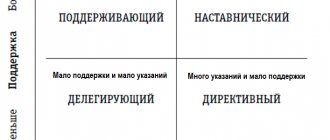Psychological climate is the mood of the team, the moral and psychological atmosphere that permeates the relationships of its participants. We are not necessarily talking about the work collective, although more often this is the case. The psychological climate exists in an interest group, in the family, in school, and in any collective activity. The success of this activity and the health of each of its participants depend on the atmosphere prevailing in the group. Creating a favorable psychological climate is included in measures to prevent psychosomatic diseases, conflicts, and neuroses.
What it is
The term “psychological climate” was first uttered by N. S. Mansurov in the context of studying a production team. A little later, psychologists began to distinguish between socio-psychological and moral-psychological climate. Psychological climate is a broad concept, the rest are included in it.
Psychological climate is the nature of emotions that arise in relationships between people, based on their sympathies, coincidence of interests, characters and inclinations. The psychological climate includes 3 areas:
- Social climate – awareness of goals and objectives by all participants, respect for rights and responsibilities.
- Moral climate - values accepted in the group. Their unity, acceptance, consistency.
- The actual psychological climate is informal relationships in the team.
There are 4 approaches to studying the psychological climate in a team:
- Climate is a collective consciousness. Awareness by each member of society of relationships in the team, working conditions, methods of stimulating it.
- Climate is the mood of the team. That is, the leading role is given not to consciousness, but to emotions.
- Climate is the style of interaction between people that influences their condition.
- Climate is an indicator of the compatibility of the group, the moral and psychological unity of its participants. The presence of common opinions, traditions and customs.
The peculiarity of the psychological climate as a phenomenon is that it is created by the person himself, he is able to influence the climate, improve and change.
Reasons for the deterioration of the emotional climate in the team
The team atmosphere is easy to disrupt. As a rule, this is caused by mistakes on the part of management. According to Irina Avetisyan, there are three main reasons for the development of imbalance.
Imperfection of the personnel management system
If the developer made mistakes at the stage of its formation, there is a high risk of creating a persistent negative atmosphere in the company. It can be formed as a consequence of procedures and mechanisms that systematically cause disputes and conflicts.
“When processes become more complicated, when a complex hierarchy is added to resolve even simple issues, if there are no standards of behavior in emergency situations and there are no regulations for actions in regular ones, conflicts and discontent in the team are inevitable,” the expert notes.
Personal qualities of a leader
Leadership style inevitably affects the morale of the team. The personal qualities of not only the heads of departments are important. The manager’s rudeness, disrespect for his subordinates, his commitment to act on the “divide and conquer” principle, multiplied by incompetence in the field of psychology of labor relations, destroy a favorable microclimate. Another dangerous flaw of management is inattention to the processes occurring within the team.
“It is important for a leader to be able to consider and extinguish a conflict at the stage of its inception,” clarifies Irina Avetisyan. “After all, it’s always easier to prevent a fire than to put it out.”
pixabay.com/
Presence of “troublemakers”
These are employees who, due to their own character or due to dissatisfaction with the conditions in the team, bring discord into its ranks:
- create in leadership;
- initiate “actions of intolerance” against another employee and remove him from the team;
- sow an atmosphere of hostility and dissatisfaction with working conditions;
- their actions lead to disorganization not only of their own working time, but also of other team members.
“You need to be able to spot such employees at the selection stage,” the expert notes. “And it is extremely important to identify “troublemakers” by monitoring the state of the psychological climate.”
Favorable and unfavorable climate
The psychological climate can be favorable or unfavorable. The first is characterized by:
- friendly attitude of participants towards each other;
- camaraderie;
- adequate mutual exactingness, which determines creative and effective activity;
- mutual assistance;
- joy from communication and openness of communications;
- safety and comfort;
- optimism;
- self-confidence and team confidence;
- the opportunity to think freely and creatively, to discover and realize one’s own potential.
But it is worth noting that a combination of mutual demands and mutual assistance is mandatory. Mutual assistance alone will turn into permissiveness, a “brotherly” attitude, which over time will create an unfavorable climate.
An unfavorable or unhealthy climate includes the opposite characteristics:
- pessimism;
- mistrust and disrespect;
- coldness and secrecy in relationships;
- inhibition of personal potential;
- irritability;
- tension and conflict;
- uncertainty;
- misunderstanding;
- fear of error, punishment and rejection;
- suspicion.
It has been noted that a healthy climate increases productivity and labor efficiency. Unfavorable climate causes frequent incidents of safety violations and reduces productivity by 20%.
A healthy climate satisfies the needs of its members and does not conflict with social norms and values. For example, in a criminal group there may be a unity of opinions, views and beliefs, but for society the activities of its members are harmful, in fact, as in the end for the participants themselves (they just don’t know it).
The concept and essence of the socio-psychological climate and its role in the labor process
The socio-psychological climate in a team is a psychological atmosphere that everyone breathes, but everyone brings something of their own to it.
The state of interpersonal relations in the work team is characterized by the socio-psychological climate. In other words, the psychological climate or psychological atmosphere is a set of psychological conditions that can promote or hinder effective joint activities and the comprehensive development of the individual in a team. This is a relatively stable psychological attitude of its members, prevailing in a group or team, which manifests itself in relation to each other, to work, to surrounding events and to the organization as a whole, based on individual personal values and orientations.
V.M. Shepel was one of the first to reveal the content of the socio-psychological climate. Psychological climate, in his opinion, is the emotional coloring of the psychological connections of team members, arising on the basis of their closeness, sympathy, coincidence of characters, interests, and inclinations. He believed that the climate of relations between people consists of three climatic zones. The first climate zone is the social climate, which is determined by the degree to which goals and objectives are realized in a given group, as well as by the extent to which all constitutional rights and responsibilities of workers as citizens are guaranteed. The second climate zone is the moral climate, which is determined by what moral values are accepted in a given group. The third climate zone is the psychological climate, those informal relationships that develop between employees who are in direct contact with each other. Psychological climate is a microclimate, the zone of action of which is much more local than the social and moral climate.
In the domestic scientific literature, the concepts of socio-psychological climate, moral-psychological climate, psychological climate, emotional climate, moral climate, etc. are widely used. As for production, they sometimes talk about the working climate of the team. In most works, these concepts are used in approximately the same sense, which, however, does not exclude significant variability in specific definitions.
In different sources you can find different definitions of socio-psychological climate.
The psychological dictionary gives the following concept of socio-psychological climate. Socio-psychological climate is a qualitative aspect of interpersonal relationships, which manifests itself in the form of a set of psychological conditions that promote or hinder productive joint activities and the comprehensive development of the individual in a group.
According to V.N. Mashkov, the socio-psychological climate is the emotional atmosphere that develops in the work collective, comfortable or uncomfortable for its members.
Platonov K.K. and Golubev G.G. offer the following definition: psychological climate is the interpersonal relationships characteristic of a work or educational group, which determine its basic mood.
Morozov A.V. indicates that the concept of socio-psychological climate does not denote certain situational changes in the prevailing mood of people, but only its stable features.
In Russian psychology, four main approaches to understanding the nature of the socio-psychological climate are identified.
Representatives of the first approach (L.P. Bueva, E.S. Kuzmin, N.N. Obozov, K.K. Platonov, A.K. Uledov) consider climate as a socio-psychological phenomenon, as a state of collective consciousness. Climate is understood as a reflection in the minds of people of a complex of phenomena related to their relationships, working conditions, and methods of stimulating it.
Proponents of the second approach (A.A. Rusalinova, A.N. Lutoshkin) emphasize that an essential characteristic of the socio-psychological climate is the general emotional and psychological mood. Climate refers to the mood of a group of people.
The authors of the third approach (V.M. Shepel, V.A. Pokrovsky, B.D. Parygin) analyze the socio-psychological climate through the style of relationships between people who are in direct contact with each other. In the process of climate formation, a system of interpersonal relationships is formed that determines the socio-psychological well-being of each group member.
The creators of the fourth approach (V.V. Kosolapov, A.N. Shcherban, L.N. Kogan) define the climate from the point of view of the socio-psychological compatibility of group members, their moral and psychological unity, cohesion, the presence of common opinions, customs and traditions.
In Western social psychology, socio-psychological climate is considered more broadly, within the framework of the concept of organizational climate, which is an integral part of organizational culture.
Thus, the concept of socio-psychological climate includes the attitude of workers to the performance of tasks and the state of relationships between team members in the production process.
The psychological mood depends on the employee’s satisfaction with his position and growth prospects, the degree of satisfaction of material and intellectual needs, the significance of the results of his work, his state of health, everyday life and other factors.
Relationships between team members are characterized by the relationship between managers and subordinates (leadership style), the nature of the relationship between employees at the same hierarchical level (the presence and focus of informal groups), as well as the attitude of subordinates. leaders.
The socio-psychological climate can be either favorable or unfavorable. Research shows that with a favorable microclimate, when there is job satisfaction in the team, an atmosphere of mutual assistance, mutual respect and trust, labor productivity increases, and the number of destructive conflicts and other unfavorable phenomena decreases. And vice versa, in an unfavorable psychological climate, in an atmosphere of confrontation and dissatisfaction among employees, the working spirit decreases, a lot of time is spent on sorting out relationships and post-conflict experience. All this has a very negative impact on labor productivity.
Job satisfaction for different people can be caused by different circumstances: the nature of the work, the prestige of the profession, the amount of wages, the significance of the results of work for society, the opportunity to get the desired job in the future, features and conditions of work (location, pleasant team, convenience of the workplace, working hours and etc.).
The leader must study and determine the specific basis of satisfaction (or dissatisfaction) with the work of each subordinate, knowing this, he can effectively stimulate motivation to work using various forms of reward.
The most important signs of a favorable psychological climate:
- an atmosphere of mutual respect, trust, cooperation and demandingness of members of the organization towards each other;
- free expression of one's own opinion when discussing various issues;
- businesslike, positive criticism of a constructive nature (including to the head);
- lack of pressure from managers on subordinates and recognition of their right to participate in decision-making;
- regular awareness of team members about tasks, problems, and state of affairs;
- satisfaction with belonging to the organization;
- tolerance for other people's opinions.
Group work, collective work is an objective reality determined by the level of development of scientific and technological progress and civilization as a whole, when the complexity of the final product is so great that the coordinated, joint efforts of specialists in various fields of knowledge and skills are necessary for its production, and this knowledge and skills must be deep enough.
It is quite difficult and sometimes impossible to master alone the entire necessary amount of knowledge, skills and abilities for the production of complex modern products - life may not be enough. The necessary depth of knowledge in one narrow area is provided by solid specialized education and experience, and this is usually enough to live on. Organizing joint productive work of specialists from different fields of knowledge, with different work experience, different ages, genders, with unique personal and professional qualifications and qualities is a task that falls on the shoulders of managers at different levels.
The group leader expects that its potential will not just be the sum of the potentials of the group members, but will also be multiplied. It is important for him to establish cooperation between team members, mutual enrichment of ideas, mutual assistance, and support. Only in this case can it be said that he used the group potential. Actually, for the sake of this, teams, work groups, departments and divisions in organizations and the organizations themselves are created (We have united to do what is impossible without such a union) [14].
The elements of group potential are:
- professional knowledge, skills and abilities that determine professional competence (qualification potential). The group can combine disparate knowledge, skills and abilities into powerful new capabilities;
- performance (psychophysiological potential);
- intellectual, cognitive abilities (creative abilities);
- the ability to cooperate, organize collectively, and interact with other groups and people from outside in the interests of common group goals (communication potential);
- value-motivational sphere, the degree of moral purity of the goals set by the group and the chosen methods of achieving them (ideological, ideological, moral potential);
- leadership potential - the group is able to become a beacon for others, turn into a reference group, one stay in which is considered a reward;
- potential for development: through the development of its employees and elements of group potential, the group is able to solve increasingly complex problems.
But in order to manage the processes occurring in the new system, the group needs to understand what is happening in it and why. Sociology and social psychology have fundamental knowledge of group processes and group behavior.
The concept of group itself is interpreted differently in different scientific disciplines. In general, this is a collection of people united by common interests (a group of fans), professions (professional qualification group), activities (enterprise employees, vehicle passengers), etc. If it is possible for one If some function is common to all, then we must talk about the group that has this function. From this point of view, the entire population of the Earth is also a group, since there is a common feature - the place of residence - planet Earth.
Real groups are such associations of people in which there is a unity of activity, conditions, circumstances, signs and in which people are in a certain way aware of their belonging to the group (although the measure and degree of awareness may be different). Groups are divided into large and small (contact). In small groups, unlike large ones, there is the possibility of direct contact between everyone, when a system of informal interpersonal relationships has developed in the group, psychological, informal small groups are formed. They have their own characteristics:
- a small number of people - from 3 to 10 (maximum 20-30 people), which is determined by the possibility of personal contacts, direct face-to-face contacts;
- are formed on the basis of a feeling of sympathy, unity of interests and hobbies, common character traits and behavior;
- the feeling of we-they is common to all group members;
- have your own unofficial leaders;
- they have their own rituals, traditions, rules, duties and sanctions.
The strength of small groups is that they are difficult to influence legally and organizationally; they have their own unwritten rules that are binding on all members of the group. The group itself, in turn, has a very serious influence on each of its members. These groups can either help the official leadership of the collective or oppose it in opposition, providing constant resistance.
Leaders need to learn to interact with these groups, and also skillfully create small psychological groups that unite people who are drawn to each other by common affairs, tasks, and interests. This greatly helps to create a favorable psychological climate in the group.
In social psychology, a small group is understood as a small group whose members are united by common social activities and are in direct personal communication, which contributes to the emergence of emotional relationships, the development of group norms and the development of group interests.
The lower quantitative limit of a small group is considered to be three people, and the upper limit is 15 people, since when this number is exceeded, two or three subgroups are immediately formed within the group.
When we are talking not just about a small group, but about a team, the required number of its members is determined, as a rule, by the goals and objectives of the joint activity. In a small high-level group, corresponding group consciousness, group values, interests, etc. arise.
Groups are divided into formal and informal. Formal are groups with legal status created by management to consolidate the division of labor and improve its organization; their role and place in the general labor process are defined in regulatory documents, for example, in the Regulations on the unit, instructions, and management procedures.
Informal groups are formed spontaneously to satisfy those individual needs of employees that, for one reason or another (incompetent leadership, authoritarian management methods, lack of humanism in leadership, etc.) are not satisfied within the formal group. This may be the need for involvement in overall success, understanding the reasons for decisions made, the need for protection, a sympathetic attitude towards them, communication, information.
The behavior of members of informal groups led by a leader can both promote and hinder the achievement of organizational goals.
If there is a problem of disunity in the team, there is no mutual understanding between employees, then this often interferes with the effective achievement of the company's goals.
The task of a leader at any level is to transform a collection of individuals into a cooperative community, into a real team.
In order for a group of professionals to act as a cohesive team, it is necessary to unite them in the pursuit of a common goal, teach them mutual assistance, initiative, self-confidence and a focus on success.
At each stage, negative trends may appear and the group may return to previous stages of development or, in general, the group may disintegrate.
There are 4 stages of group cohesion:
- Orientation of group members in a social situation, the formation of common value orientations.
- Mutual adaptation of group members, consolidation of positive personal relationships between most of them.
- Deep internalization (development by all group members of their own norms, rules, goals, guidelines).
- Transforming the group into a coherent community.
At the team formation stage, teams solve problems of compatibility of team members. The same problem arises in the event of any changes in the composition of the group, the status of its members, the organization and working conditions of the group, the arrangement of jobs, technology, or simply when signs of problems appear in the team, tension appears in the relationship. The work collective is a living and developing organism, all elements of which also change under the influence of external circumstances.
In the sociology of labor, the following types of compatibility are distinguished:
- physical (in terms of strength parameters, endurance);
- psychophysiological (according to the parameters of analytical systems, such as visual, olfactory, tactile, auditory, and their sensitivity);
- socio-psychological (based on complex personality traits, such as character, temperament);
- socio-ideological (according to social values).
The cohesion of a team also depends on the stages of its maturity. There are 5 stages of team maturity:
- Grinding in is interaction in familiar forms. There is no collective creativity. Leaders play a critical role in cohesion.
- Conflict is a period when disagreements are openly expressed, groups are formed, and the strengths and weaknesses of individuals are revealed. The struggle for leadership and the search for compromises between the warring factions begins. Possible confrontation between the manager and individual subordinates.
- Experimentally - the potential of the team increases, there is an interest in working better using other methods and means, but the team works in fits and starts.
- Successful solution to the problem. They approach assigned tasks creatively and realistically. The functions of a leader are transferred from one to another depending on the situation.
- Forming strong connections. Team members value each other and personal differences are quickly resolved. Relationships are mostly informal. All together produces high performance results and high standards of behavior.
A group can subjugate a person, force him to act contrary to his own beliefs, but only if being in the group is more valuable to the person than maintaining his own moral principles, or if leaving the group puts his health or even life at risk.
The group helps a person to internalize his norms and values and carry out socialization. A person cannot be outside any group for a long time: outside of society, outside a group of his own kind, a person degrades, loses the ability to communicate and interact with other people. Thus, the prototype of Robinson Crusoe, the sailor A. Selkirk (information about him appeared on the pages of the press), after a long stay on a desert island, he could not return home and become a full-fledged member of society again: he sought solitude, he lived in the most remote corner of his father’s estate and died pretty soon.
The socio-psychological climate is an integral part of more defined group conditions. It does not arise spontaneously, but is the result of the efforts of many people - leaders and group members. A favorable socio-psychological climate is a state of satisfaction of each person with his work and relationships with employees. Psychologists and conflict specialists can provide great assistance in improving the socio-psychological climate.
Climate levels
Climate has two levels: static and dynamic.
Static
This is a stable attitude of employees towards work, constant interpersonal relationships. The climate is stable and tolerates external influences well. It is not easy to create a climate at this level, but then it is easy to maintain. Team members feel this stability, which makes them more confident in their own position. Climate correction is practically not required, control is occasional. This level is also called the socio-psychological climate.
Dynamic
This is the changing nature of the team. The climate changes daily due to the changing moods of its participants. This level is also called the psychological atmosphere. It changes faster and is less felt by the participants. As changes accumulate, it can create an unhealthy climate in the team.
Levels and indicators of the socio-psychological climate of the organization
When studying the socio-psychological climate of a team, two levels are distinguished.
The first level is static, relatively constant. These are stable relationships among team members, their interest in joint group activities and in each other. At this level, the socio-psychological climate is understood as a stable, fairly stable state, which, once formed, is capable of not being destroyed for a long time and maintaining its essence, despite the difficulties faced by the team. From this point of view, creating a favorable climate in a group is quite difficult, but at the same time it is easier to maintain it at a certain level, already formed earlier. Monitoring and adjustment of the properties of the socio-psychological climate is carried out by group members from time to time. They feel a certain stability, the stability of their position, status in the system of relations. Since the state of the climate is less sensitive to various influences and changes from the environment, it has a certain impact on the results of collective and individual activities, on the productivity of group members, on the quality and quantity of the results of their activities.
The second level is dynamic, changeable. This is the daily mood of the group members in the process of activity, their psychological mood. This level is described by the concept of psychological atmosphere. Unlike the socio-psychological climate, the psychological atmosphere is characterized by faster temporary changes and is less conscious of people. Changing the psychological atmosphere affects a person’s mood and performance during the working day. Climate changes are always more pronounced, noticeable, they are more acutely perceived and experienced by people; most often a person manages to adapt to them. The accumulation of quantitative changes in the psychological atmosphere leads to its transition to a different qualitative state, to a different socio-psychological climate.
Indicators of a favorable socio-psychological climate of the student body.
The group is dominated by a cheerful, cheerful tone of relations between colleagues, optimism in the mood; relations are built on the principles of cooperation, mutual assistance, and goodwill; approval and support prevail in relationships, criticism is expressed with good wishes.
Personal qualities such as responsibility, honesty, hard work and selflessness are highly valued in the team.
The successes or failures of individuals in a group generate sympathy and genuine participation from all group members.
There is mutual understanding and cooperation between groups within a collective group.
Indicators of unfavorable socio-psychological climate of the student body:
- The work team is dominated by a depressed mood, pessimism, conflicts, aggressiveness, hostility of colleagues towards each other, and rivalry;
- Members of the collective are inert, passive, some strive to isolate themselves from the rest, the work collective cannot rise to a common cause.
The successes or failures of one person leave the rest of the team indifferent, and sometimes cause unhealthy envy.
Conflicting groups arise in the team and refuse to participate in joint activities.
In difficult cases, the work team cannot unite, confusion, quarrels, and mutual accusations arise; The team is closed and does not seek cooperation with other teams.
Thus, the socio-psychological climate of a team is an important indicator of its condition, which makes it possible to judge the following characteristics of the team: the degree of psychological involvement of its members in activities; the degree of coordination of their efforts and relationships; a measure of the psychological effectiveness of this activity; about the level of intellectual potential of the individual and the team, their not only realized, but also hidden, untapped reserves and capabilities; the scale and depth of obstacles standing in the way of realizing the psychological reserves of the team; and, finally, about the shifts that occur in the structure of the mental potential of the individual and the team as a whole.
Climate diagnostics
The socio-psychological climate in a team is an indicator of the level of development of the team. Therefore, it is important to regularly carry out diagnostics and monitor dynamics, to identify the properties that hold the team together or destroy it. For this purpose, the method of assessing the level of psychological climate of A. N. Lutoshkin’s team is suitable.
The subject is asked to answer 13 statements regarding the team in which he is located. The score can be from -3 to 3.
Answer form
22 points and more – highly favorable climate.
8-22 points – moderately favorable climate.
0-8 points – low favorable climate.
From 0 to -8 – initial unfavorability.
From -8 to -10 – moderately unfavorable climate.
From -10 and more – pronounced unfavorability, unhealthy climate.
Each team member takes the questionnaire. When summing up, all points are summed up and divided by the number of people surveyed. The final number is the overall score of the team. You can also calculate an overall score for individual criteria.
Climate structure
The following relationships are distinguished in the structure of the psychological climate:
Horizontal
How cohesive is the team? What are the relationships of its members with each other? If conflicts arise, how are they resolved? Psychologists answer these questions by analyzing relationships horizontally.
Vertical
If in the previous paragraph we are talking about interpersonal relationships of equal members of society, here communication with the boss and other higher-ranking colleagues takes place.
Attitude to work
Is everything good regarding this aspect? To answer this question, a person must think about how satisfied he is with his activities and whether he intends to remain where he is currently doing them.
Signs characterizing climate
Externally, you can judge the climate of a team by the following signs (useful for those applying for a job):
- staff turnover;
- product quality;
- level of discipline;
- claims and complaints, negative feedback from employees;
- frequent breaks from work;
- negligence and carelessness.
The better these indicators, the more favorable the climate. Signs of a favorable climate also include:
- trust and high demands in relationships;
- kind and constructive criticism;
- freedom of speech and opinion;
- providing initiative to employees, lack of managerial pressure;
- awareness of participants in team issues;
- satisfaction from belonging to this group;
- mutual assistance and highly developed empathy;
- responsibility for yourself and the entire team.
Why is it important to maintain a positive workplace climate?
Companies that improve work and care about psychological comfort automatically increase their rating among employers. The personnel of such companies are motivated to achieve results and are involved in the development process. Maintaining a positive microclimate also contributes to:
- reducing the staff turnover rate;
- increasing employee loyalty in difficult crisis situations (for example, in case of delayed wages);
- timely identification of problems such as office bullying, the emergence of toxic informal leaders;
- creating opportunities for professional growth within the company.
Arranging classrooms and creating a positive microclimate will require financial and time expenditures. But the approach will save money in the long run. The cost of maintaining offices with the “correct” design is low, and even small companies can afford team building. Sometimes people chip in themselves and organize small celebrations. The manager’s task is not to interfere with employee initiatives, but to support them.
What affects climate
The climate is influenced by a number of factors:
- Type of organization, team. Open or closed, private or public, scientific or industrial organization. Family, class, criminal group, charitable association.
- The image and standard of living of the team members.
- Micro (everyday for a particular person) and macro (city, country, culture of society) conditions: normal, complicated, extreme.
- Rational organization of work, compliance with the regime and rights, taking into account the capabilities and characteristics of each team member.
- Team structure.
- Informal leaders or groups in a team.
- Leadership style and features. A favorable climate requires attention from the manager not only to production issues, but also to the personal problems of team members. That is, the democratic style.
- Individual psychological and personal characteristics of team members. Personal opinion, mood and behavior of a person contribute to the overall climate. This is based on passing external factors and events through the prism of one’s own character and personality.
- The combination of the characteristics of all participants forms a new collective quality - the psyche of the collective. Therefore, the psychological compatibility of the participants, primarily in terms of temperament, plays a big role. Psychologically, people must be compatible in terms of psychomotor reactions, emotional and volitional manifestations, the work of thinking and attention, and character. Incompatibility causes antipathy, hostility, and conflicts.
- Self-assessment of each participant. His self-awareness and the correspondence of claims and achievements.
The leader has a great influence on climate formation. You should pay attention to his personal qualities, attitude towards other participants, authority, leadership style. A positive climate is created by a leader who:
- principled;
- responsible;
- active;
- disciplined;
- kind, responsive and sociable;
- has organizational skills.
Rudeness, selfishness, inconsistency, disrespect, and careerism have a negative impact on the health of the climate.
The conditions that dictate the climate also depend on the leader. Necessary:
- be friendly and respectful in relationships;
- provide employees with the opportunity to choose their own area of activity;
- notice and celebrate the activity and creativity of employees;
- promote employee interest in self-development;
- motivate employees for career advancement with the aim of not only material gain, but also to gain prestige and recognition from the team;
- be a good qualified leader and a kind mentor.
What a leader can do for a favorable climate:
- It is justified from a psychological standpoint to select personnel.
- Organize regular training and certification.
- Study and practice the theory of psychological compatibility, that is, have a good understanding of people.
- Contribute through practical activities (through organizing events) to the development of interaction and relationship skills.
How to understand that there is an unhealthy atmosphere at work
It is customary to discuss colleagues behind their backs
Of course, if behind your back you hear mostly praise or discussions about how to please or help a person, then this is a wonderful team. But in reality, employees much more often break each other’s bones, look for flaws and pass on gossip using the method of a broken phone.
As a result, the office or factory floor turns into a battlefield. And you don't allow yourself to relax for a second. You are forced to constantly monitor your behavior so that your actions are not misinterpreted, and everything you say is not used against you. It is quite difficult to work in such a stressful atmosphere.
Employees are criticized unconstructively
Everyone in the team is people, and people, whether line employees or management, tend to make mistakes. So sometimes the result of the work is not what we would like it to be. Moreover, no one can work with the same productivity all the time. Therefore, from time to time there is a need to honestly admit that things didn’t work out very well and discuss how things can be improved.
Criticism helps you develop, so there is nothing scary about it. Another point is how it is presented.
It happens that no one notices successes, but everyone strives to rub their nose into mistakes. It's unpleasant, although it's not so bad. The trouble begins where criticism turns into bullying. For example, in response to an idea, even if it is not a very good one, a person receives sarcasm and derogatory remarks. Or the boss criticizes not the work, but the performer himself. Agree, there is a difference between “Let’s admit, it turned out frankly bad. This needs to be redone” and “You’re just bad, what else could you do!” Redo it."
Colleagues allow themselves harsh jokes
Jokes on the edge are appropriate if people have been communicating for a long time, well understand the context of the statements and know for sure that everyone will understand everything correctly.
This rarely happens in a work group, and common sense tells you to hold your horses. Because among friends, for example, a stupid racist joke can still come off as “Guys, you’ve known me for a long time, I’m not like that and I understand that these are just stereotypes, but this is a funny thought, and I just can’t resist speaking out.” But in the office it will definitely sound unacceptable.
Discriminatory statements can also be offensive to people who are not affected by them. For example, brunettes can react sharply to jokes about the stupidity of blondes. Because it’s not the blondes who are stupid here, it’s jokes like these. When such remarks develop into barbs directed at those present, this is outright evil, the source of which well understands what it is doing. From here, bullying is just a stone's throw away.
There is an outcast in the team
Mobbing, that is, bullying a person in a work group, is a common problem. For example, E.V. Demina, E.B. Milinkis, S.E. Milinkis, K.S. Polagin were subjected to it. Study of the manifestation of mobbing in Russian companies / T-Comm - Telecommunications and Transport 135 out of 180 participants in one Russian survey.
Even if the victim of bullying is not you, but someone else, its very presence indicates that the relationships in the team are not very healthy. Because adults and emotionally mature people solve problems differently, and hardly anywhere hire kindergarteners.
It is not only the outcast who experiences negative emotions in an atmosphere of bullying. Moreover, if he quits, with a high degree of probability the crowd will simply look for a new victim. So it's hard to work in such an environment.
Bosses promote unhealthy competition
There are companies with a simple and transparent motivation system. Everyone understands how to earn more and get a promotion - to perform their duties better or offer fresh ideas. Employees are assessed strictly according to their professional competencies.
But there are also companies where they reward and punish solely according to the decision of management. Therefore, the team spends a significant part of its time not on work, but on intrigue and searching for opportunities to drown their neighbor and rise against their background. The bosses, as a rule, are only amused by this, otherwise the processes would be structured differently.
Alas, it will be difficult for people who are not ready to play by such rules in such an atmosphere. No matter how good a specialist a person is, he will be at the bottom of the office hierarchy due to the fact that he is unsuccessful in behind-the-scenes games. And although this does not say anything about his working skills, it hits his self-esteem.
Corporate values are emphasized too much
Corporate values themselves are not so bad, but much depends on how they are implemented.
Let's take the topic of nepotism. While working in companies with a small staff, everyone becomes really close - almost like family. But in this situation, everything usually comes from within. When these “kindred feelings” are implanted from the outside, as a rule, nothing good can be expected. This usually does not mean that you will always be understood and accepted by anyone, and will do everything for your well-being. Rather, on the contrary, you will be pushed through personal boundaries - but what’s wrong, we are a family; overwork - it’s difficult to go out on weekends for a common cause; accusations of betrayal if you decide to change jobs - how can you set us up.
Another red flag is too frequent statements like “you’re just lucky to work in our company.” Usually this is followed in any controversial situation by a devaluation of merit: you should be grateful, not indignant, not demand normal conditions and a decent salary, who are you anyway? This type of attitude towards employees creates extremely fertile ground for toxicity.
Work makes you unhappy
Sometimes everything is fine with the team and working relationships, but the atmosphere becomes unhealthy only for you.
Let's imagine the situation. You don't like communicating with colleagues; you only talk to them when you need to discuss work issues and if you have no other choice. There are no days when you go to work with joy. Your self-esteem and mood have become much worse than when you first got this job. You are constantly under stress. You feel like you're in corporate hell.
If everything is so, there is a high probability that for you personally this is it. You may spend a long time beating yourself up and thinking that it is you who are unable to integrate into the team. That you don’t want to go to work because you’re lazy. That there is no joy in life, because after 25 years no one has it.
In this case, perhaps the point is not that the team is toxic, but that you are out of place and it simply does not suit you.
Creating a favorable climate
A favorable climate is formed where participants clearly see the goals of the team, clearly understand and accept them. At the same time, they have a flexible system of means and ways to achieve them.
The higher the level of development of the team, the more favorable the climate. However, even at a low level of development, a favorable climate can be created.
It is important to maintain the unity of motives, interests, beliefs, ideals, attitudes, needs of the participants and correctly combine their individual characteristics.
A favorable psychological climate cannot arise by itself. This is the product of the coordinated and hard work of the entire team, and the competent organizational activities of the leader.
Purposeful work must be carried out to create a favorable climate. This is a responsible and creative undertaking that requires knowledge of human psychology, the ability to predict likely situations in relationships, and understand emotions and their regulation.
Creating climate begins with changes in each individual person. In order for interpersonal relationships to develop favorably, you need to:
- work on your own negative character traits;
- to form positive moral qualities (respect for people, recognition of their dignity and honor, attention, recognition of the beliefs and interests of other people, trust, observance of politeness and rules of behavior, objective assessment and self-esteem, tact);
- use polite words and phrases, observe etiquette;
- master methods of emotional and mental self-regulation (necessary for the prevention and elimination of irritation, resentment, burnout, nervousness, anger, fatigue, agitation, apathy);
- know strategies for behavior in conflict situations and be able to resolve them competently;
- avoid maximalism in judgment and behavior, egocentrism, labeling, categoricalness, inflated expectations and ideas.
Each member of the team should be valuable, unique and positive in their own way, and in a group setting they should complement each other, not interfere or overshadow each other.
Microclimate assessment and main influencing factors
First, you should find out what is happening in your team at the moment: what prevailing emotions, experiences and moods, whether conflicts occur, whether there is an understanding of the common goal of the company and the desire to realize it.
You can obtain information in several ways:
- At general meetings.
- During personal conversations with individual employees.
- Using an anonymous survey.
It is advisable to perform the analysis regularly, since many factors can dramatically change the current situation. The work environment is affected by:
- group compatibility. Employees operate with their own basic concepts and general ideas and perform a specific task. However, well-coordinated teamwork is built on emotional unity and sharing of company values. If the staff speaks different languages, does not reach a compromise on simple issues, does not understand the main goals, the situation will not allow them to do the work effectively;
- Nature of activity. Each position in the company has its own characteristics - emotional intensity, monotony, increased responsibility, and the presence of stress factors. All this affects the socio-psychological microclimate;
- level of job satisfaction. Ideally, work arouses interest, brings a sense of satisfaction, self-worth, and provides the opportunity for professional development. To maintain a favorable atmosphere, it is necessary to respond to the needs of the team in a timely manner: introduce effective systems of material and non-material motivation, pay attention to training, encourage initiative, and the desire for career growth. Otherwise, enthusiasm in the team will quickly subside;
- working conditions. To get maximum results, it is worth providing employees with a comfortable, specially equipped workplace. Poor lighting, extraneous noise, and stuffiness are a source of stress and irritability for employees. This is incompatible with the concept of a healthy atmosphere;
- leadership style. The formation of a normal microclimate is facilitated by a democratic management style, in which there is no imposition of decisions, friendly, trusting relationships prevail, and team members are equally valued. Permissive and authoritarian styles lead to low productivity, the emergence of hostility, envy, and mistrust;
HR management styles chart
- nuances of the global and local microenvironment. Additionally, the situation is influenced by stability in the political and economic spheres of society, the social and psychological well-being of team members. The structure of the organization, the opportunity to participate in planning and decision-making, and the elimination of functional-role contradictions play a role.
With a normal internal microclimate, employees are satisfied with working conditions and the amount of material remuneration, are focused on results, share common goals, support and respect colleagues, notice prospects for growth, and make long-term plans. Problems on any of the points are a sign that it is time to take appropriate action.
Satisfaction as a criterion
The basis for climate assessment is people’s satisfaction/dissatisfaction with relationships in the team and the activity itself. However, you need to understand that satisfaction can be subjective and objective.
It often happens that one person is completely satisfied with the team, while another is not at all satisfied with the working conditions. This is subjectivity in assessment. Differences in experience, conditions and quality of life, interests, character of people and other individual characteristics contribute. The principle of subjective satisfaction is the relationship between the parameters “I give” and “I receive”.
Dissatisfaction with delayed wages, regular punishments, non-compliance with labor standards, violation of rights is an objective indicator.
Management style and specifics of the enterprise
When choosing a manager, it is very important to take into account not only personal qualities, but the specifics of the enterprise’s activities. This is an important aspect that determines the optimal leadership style for successful conduct of activities within the enterprise as a whole, and in each link in particular.
Basic management styles:
Photo by Christina Morillo from Pexels
- democratic – develops sociability and trust in relationships, and involves the participation of each member of the team in the management process.
- authoritarian – based on the formal authority of the leader. Characterized by the complete subordination of ordinary team members to the instructions and orders of the leader;
- conniving - characterized by the lack of active participation of the manager in managing the team. With this management style, each team member has a maximum degree of freedom.
Based on the definition of management styles, it is quite obvious that you cannot choose a leader who tends to use an authoritarian management style to lead within creative teams, and accordingly, a conniving style is not at all acceptable for military units or sports teams.
Afterword
Psychological climate is sometimes identified with socio-psychological or moral-psychological, which further emphasizes its basis. The basis of a favorable climate is the unity and similarity of values among team members.
The nature of the climate affects the individual: whether or not it stimulates work, joint activities, raises or lowers the mood, instills faith or self-doubt in one’s own strength, cheerfulness or despondency, stimulates or suppresses activity.
It is very easy to guess the nature of the climate. It is enough for its participants to only answer the questions “like - don’t like”, “satisfied - doesn’t suit”, “would like - don’t want to be in a team.”
Learn about what the psychological climate in a team is and how to create a favorable climate from the specialists of the Synergy University of Self-Development.
Definition of the concept
The level of favorableness of the work environment is determined by the quality of the psychological climate.
Photo by Canva Studio: Pexels
If we take the most common definitions of the concept of “psychological climate,” we can get something like this:
- Psychological climate is a set of factors that determine the psychological state of the work team participating in the general production process.
- Psychological climate is a qualitative characteristic of interpersonal relationships, which is expressed in the sum of psychological factors that promote or hinder joint activities and personal development in a group.
The harmonious development of a person’s personality is directly related to the ability to realize oneself within a group or team. The processes of development of the individual and the team are very closely interconnected and interdependent: the structure of the team, the rules of relationships, the opportunity for self-expression and development.











